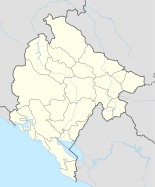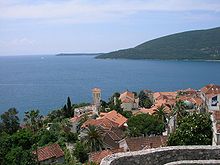Herceg Novi
|
Herceg Novi ерцег Нови |
||||
|
||||
| Basic data | ||||
|---|---|---|---|---|
| State : |
|
|||
| Municipality : | Herceg Novi | |||
| Coordinates : | 42 ° 27 ' N , 18 ° 32' E | |||
| Height : | 5 m. i. J. | |||
| Residents : | 12,739 (2003) | |||
| License plate : | HN | |||
Herceg Novi ( Montenegrin - Cyrillic Херцег Нови , Italian Castelnuovo ) is a city in western Montenegro , in the municipality of the same name with about 12,700 inhabitants. The associated community has a total of around 33,000 inhabitants (2011). The place is located on the Adriatic Sea at the entrance to the Bay of Kotor and is especially important for tourism.
The “Dr. Simo Milošević “, which uses the slightly radioactive sea mud as a basis for a variety of therapies.
The city is laid out in terraces, with the three-kilometer-long promenade "Pet Danica" at the center, on the sea side of which there is a two-kilometer-long, mostly concrete beach. The path is lined with countless restaurants and stalls, as well as various discos and hotels. The spa is open all year round, with summer visitors flocking to Herceg Novi around mid-June.
There is also an old town that is well worth seeing. Especially recently, Herceg Novi has become a destination for mass tourism. This development has damaged the city's reputation as a vacation destination. One of the most famous hotels is the “Plaza” hotel.
There are nicer bathing opportunities on the east side of Herceg-Novi, where the towns of Meljine , Zelenika and Bijela stretch along the coast and also contributed to the popularity of water polo in the region. The local club PVK Jadran Herceg Novi has been champions of Yugoslavia and Montenegro several times and was in the 2004 final of the Euro League.
history
The place was founded in 1382 as Sveti Stjepan by the Bosnian King Tvrtko I , who wanted to get his own port so that he would no longer have to rely on the autonomous trading cities of Dubrovnik and Kotor .
The name Herceg Novi, which is still in use today, reminds us that in the 15th century the town belonged to Duke Stjepan Vukčić Kosača , from whose title the name of Herzegovina is derived. Herceg Novi is the youngest town to be founded in the Adriatic region, where most towns go back to antiquity and only a few were added in the Middle Ages. Even though it was founded by Slavs, Herceg Novi received municipal statutes that were similar to those of the old cities and were thus shaped by the Roman legal tradition (e.g. Budva or Bar ).
As the only permanent place on the Bay of Kotor , Herceg Novi did not fall to the Venetians after 1420; rather, the city was captured by the Turks in 1482 when they conquered Herzegovina. Herceg Novi remained in their possession with one interruption (1538/1539) until the Great Turkish War (1683–1699). In 1687 Gerolamo Cornaro , the Provveditore generale of Dalmatia , was able to conquer "Castelnuovo" (so called now) for the Republic of Venice . The " Serenissima " proposed its new acquisition to the so-called Venetian Albania , which was administered from Cattaro.
After the fall of the Republic of St. Mark (1797) and changing masters during the Napoleonic Wars, the place, which was still called Castelnuovo, came under Austrian rule for a century in 1815 and became part of the Kingdom of Serbs, Croats and Slovenes in 1919 . Only then did the name Herceg Novi apply again.
During the Second World War, first Italian (1941–1943), then German occupied, the city was conquered by the communist - Yugoslav partisans on October 28, 1944 and immediately afterwards became part of the Republic of Montenegro .
population
At the 2011 census, the municipality of Herceg Novi had 30,864 inhabitants, of whom 15,090 (48.89%) identified themselves as Serbs , 10,395 (33.68%) as Montenegrins and 662 (2.14%) as Croatians . In addition, other smaller population groups live in the city, including the Roma .
Personalities
- Ahmed-paša Hercegović (around 1456–1517), grand vizier and general
- Leopold Mandić (1866–1942), Croatian clergyman and saint of the Roman Catholic Church
- Gottfried von Banfield (1890–1986), Austrian officer
- Gustav Heinse (1896–1971), German poet and translator
- Anton Mader (1913–1984), Austrian general
- Danka Kovinić (* 1994), tennis player
- The film director Emir Kusturica has been spending his holidays in Herceg Novi for many years. He set up the Zhalo cultural center in an old train station , which also operates the Aurora cinema .
Town twinning
- Novo mesto ( Slovenia )
literature
- Ratomir Rade Radanović: Herceg Novi. 1918-1945 . (= Edicija Hronika gradova . 7). Beograd [u. a.] 2005, ISBN 86-7596-064-6
- Tomo Krstov Popović: Herceg-Novi. Istorijske biljeske . Volume 1: 1382-1797 . Herceg-Novi 1924.
- Nicolo Barnaba Gjonovic: Castelnuovo (Hercegnovi). Topographical and historical description . Graz 1902.





